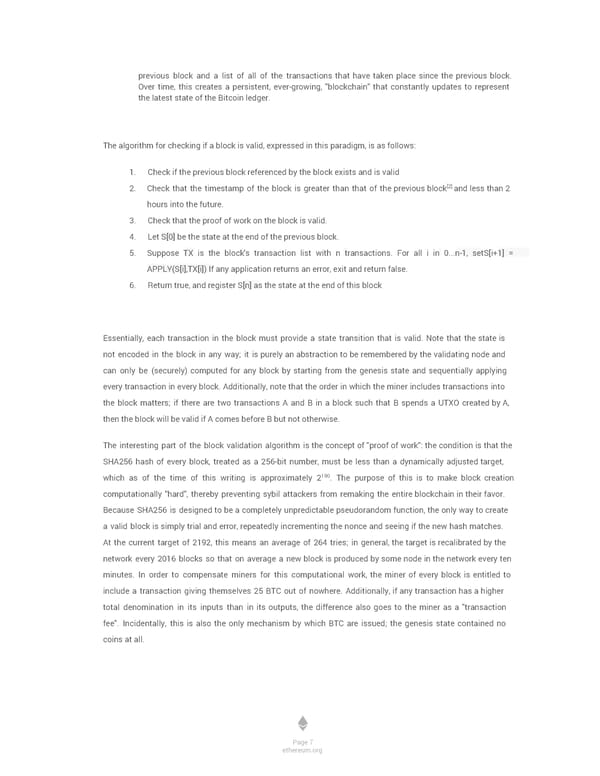previous block and a list of all of the transactions that have taken place since the previous block. Over time, this creates a persistent, ever-growing, "blockchain" that constantly updates to represent the latest state of the Bitcoin ledger. The algorithm for checking if a block is valid, expressed in this paradigm, is as follows: 1. Check if the previous block referenced by the block exists and is valid [2] 2. Check that the timestamp of the block is greater than that of the previous block and less than 2 hours into the future. 3. Check that the proof of work on the block is valid. 4. Let S[0] be the state at the end of the previous block. 5. Suppose TX is the block's transaction list with n transactions. For all i in 0...n-1, setS[i+1] = APPLY(S[i],TX[i]) If any application returns an error, exit and return false. 6. Return true, and register S[n] as the state at the end of this block Essentially, each transaction in the block must provide a state transition that is valid. Note that the state is not encoded in the block in any way; it is purely an abstraction to be remembered by the validating node and can only be (securely) computed for any block by starting from the genesis state and sequentially applying every transaction in every block. Additionally, note that the order in which the miner includes transactions into the block matters; if there are two transactions A and B in a block such that B spends a UTXO created by A, then the block will be valid if A comes before B but not otherwise. The interesting part of the block validation algorithm is the concept of "proof of work": the condition is that the SHA256 hash of every block, treated as a 256-bit number, must be less than a dynamically adjusted target, 190 which as of the time of this writing is approximately 2 . The purpose of this is to make block creation computationally "hard", thereby preventing sybil attackers from remaking the entire blockchain in their favor. Because SHA256 is designed to be a completely unpredictable pseudorandom function, the only way to create a valid block is simply trial and error, repeatedly incrementing the nonce and seeing if the new hash matches. At the current target of 2192, this means an average of 264 tries; in general, the target is recalibrated by the network every 2016 blocks so that on average a new block is produced by some node in the network every ten minutes. In order to compensate miners for this computational work, the miner of every block is entitled to include a transaction giving themselves 25 BTC out of nowhere. Additionally, if any transaction has a higher total denomination in its inputs than in its outputs, the difference also goes to the miner as a "transaction fee". Incidentally, this is also the only mechanism by which BTC are issued; the genesis state contained no coins at all. Page 7 ethereum.org
 Ethereum White Paper by Vitalik Buterin Page 7 Page 9
Ethereum White Paper by Vitalik Buterin Page 7 Page 9